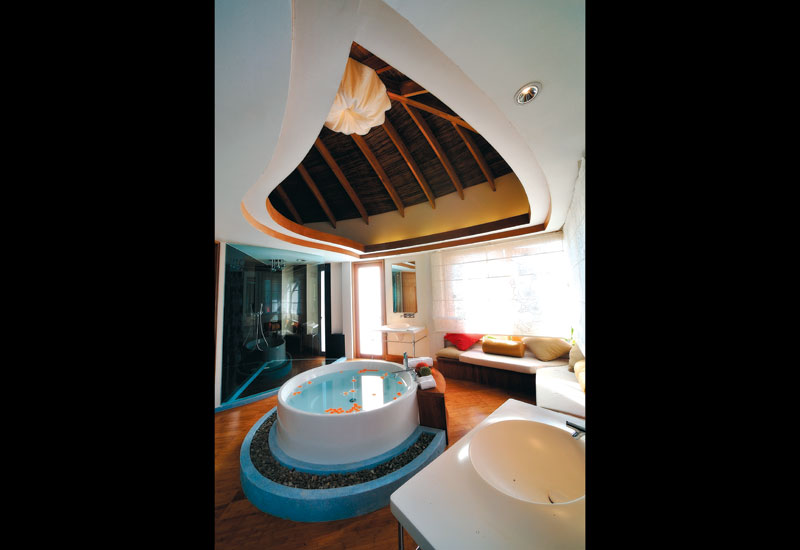THE FUNCTION VS FORM DEBATE
The function versus form debate rages on when it comes to hotel design, with two of the designers Hotelier Middle East spoke with sitting on opposite sides of the fence on this subject. For Miaja Design Group’s principal Isabelle Miaja and director Martin van der Reijden, aesthetics must come first, but on this note they find themselves head to head with Martin Wojnowski, design principal at Design Work Portfolio, for whom practicality is paramount.
Miaja says: “Design is first and foremost about aesthetics and only thereafter about practicality, durability and timelessness.
“You have to dream up a design before you make it practical, the other way around of taking something practical and trying to make it beautiful normally does not work.”
For example, she says they are currently “dreaming up a new Maldivian Resort, small and extremely high-end, and are just discussing whether a two-curved wall is feasible”.
“The answer is probably going to be yes but quite expensive, so why don’t we make the wall straight? Well, because it would not be as beautiful,” says Miaja, pointing to the idea that the Sydney Opera House “could have had flat roofs” to illustrate her point.
But for Wojnowski, the commercial role of an interior designer to accelerate financial returns for a hotel owner demands that function is the primary consideration.
“Practicality always comes first in a hotel or resort. Personally I always develop the circulation of the public spaces and required back-of-house areas first. I know how a hotel works because I actually worked in restaurants, housekeeping, concierge and front office,” says Wojnowski. “It was 20 years ago. I had to earn a living as a student. I never expected this experience would prove to be crucial in my future as a designer. Without the practical, hands-on knowledge of the operating, “living” hotel, I would have never even have thought about laying a groundwork for a hotel layout.
“Interior design is an awfully practical exercise,” he continues. “It is a lot to do with money and lead times and deadlines. Unfortunately design schools do not prepare people for all that. Not enough emphasis is put on financial planning.”

Advertisement
Aukett Fitzroy Robinson’s Kuzyk says the drivers for aesthetics and the drivers for functionality often contradict each other, but suggests looking to examples in history for the perfect fusion of both, “such as Yin and Yang”.
“It is not so much a question of balance between achieving high design and functionality as it is a question of achieving total unity,” says Kuzyk.
Economic challenges have resulted in hotel budgets being compromised, but designers are adamant that this should not impact upon the quality of the project, either during structural construction or interior fit out.
Aukett Fitzroy Robinson’s Kuzyk puts the onus on the interior designer to ensure standards don’t slip.
“The greatest concern for designers is the short-term approach regarding quality of finish and construction, putting occupancy levels and transaction activity at risk. We need to strike a balance between quality of design and quality of construction,” says Kuzyk.
“There is no doubt that recession drives creativity in a very positive way. Designers need to think outside the box. Good quality products and fittings must be used throughout any hotel design and it is the manner in which they are used that maintains quality and saves money in the long term,” she says.
Rockwell Group Middle East managing director Chuck Wood agrees that it is down to interior designers to re-address how they can deliver their services more efficiently, especially considering the competitiveness in fees.
He says: “Design is coming up with the best possible solution given a certain set of goals and constraints and price is just one of those constraints. I don’t think there is any requirement that a low budget doesn’t mean a great design”.
However, Interior Motives managing director Julia Dempster says that educating hotel owners determined to squeeze budgets as to the critical importance of quality goods is increasingly challenging.
“This is happening more and more frequently and we are having real difficulty getting owners to see that paying more to start with is more cost-effective. Some of the worst offenders are some Chinese lighting manufacturers; lighting is arriving on site rusty, not straight, with cheap dented shades and light fittings that burn when you touch them, which have both a massive impact on the look of the project and more importantly safety,” says Dempster.









 Search our database of more than 2,700 industry companies
Search our database of more than 2,700 industry companies









